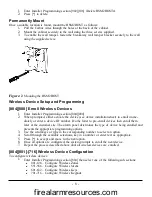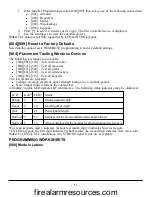
Control units, intrusion detectors, smoke detectors and many other security devices
require an adequate power supply for proper operation. If a device operates from
batteries, it is possible for the batteries to fail. Even if the batteries have not failed, they
must be charged, in good condition and installed correctly. If a device operates only
by AC power, any interruption, however brief, will render that device inoperative
while it does not have power. Power interruptions of any length are often accom-
panied by voltage fluctuations which may damage electronic equipment such as a
security system. After a power interruption has occurred, immediately conduct a com-
plete system test to ensure that the system operates as intended.
Failure of Replaceable Batteries
This system’s wireless transmitters have been designed to provide several years of bat-
tery life under normal conditions. The expected battery life is a function of the device
environment, usage and type. Ambient conditions such as high humidity, high or
low temperatures, or large temperature fluctuations may reduce the expected battery
life. While each transmitting device has a low battery monitor which identifies when
the batteries need to be replaced, this monitor may fail to operate as expected. Regular
testing and maintenance will keep the system in good operating condition.
Compromise of Radio Frequency (Wireless) Devices
Signals may not reach the receiver under all circumstances which could include metal
objects placed on or near the radio path or deliberate jamming or other inadvertent
radio signal interference.
System Users
A user may not be able to operate a panic or emergency switch possibly due to per-
manent or temporary physical disability, inability to reach the device in time, or unfa-
miliarity with the correct operation. It is important that all system users be trained in the
correct operation of the alarm system and that they know how to respond when the
system indicates an alarm.
Smoke Detectors
Smoke detectors that are a part of this system may not properly alert occupants of a
fire for a number of reasons, some of which follow. The smoke detectors may have
been improperly installed or positioned. Smoke may not be able to reach the smoke
detectors, such as when the fire is in a chimney, walls or roofs, or on the other side
of closed doors. Smoke detectors may not detect smoke from fires on another level
of the residence or building.
Every fire is different in the amount of smoke produced and the rate of burning.
Smoke detectors cannot sense all types of fires equally well. Smoke detectors may not
provide timely warning of fires caused by carelessness or safety hazards such as
smoking in bed, violent explosions, escaping gas, improper storage of flammable
materials, overloaded electrical circuits, children playing with matches or arson.
Even if the smoke detector operates as intended, there may be circumstances when
there is insufficient warning to allow all occupants to escape in time to avoid injury or
death.
Motion Detectors
Motion detectors can only detect motion within the designated areas as shown in their
respective installation instructions. They cannot discriminate between intruders and inten-
ded occupants. Motion detectors do not provide volumetric area protection. They
have multiple beams of detection and motion can only be detected in unobstructed
areas covered by these beams. They cannot detect motion which occurs behind walls,
ceilings, floor, closed doors, glass partitions, glass doors or windows. Any type of
tampering whether intentional or unintentional such as masking, painting, or spraying
of any material on the lenses, mirrors, windows or any other part of the detection
system will impair its proper operation.
Passive infrared motion detectors operate by sensing changes in temperature.
However their effectiveness can be reduced when the ambient temperature rises near
or above body temperature or if there are intentional or unintentional sources of heat
in or near the detection area. Some of these heat sources could be heaters, radiators,
stoves, barbeques, fireplaces, sunlight, steam vents, lighting and so on.
Warning Devices
Warning devices such as sirens, bells, horns, or strobes may not warn people or
waken someone sleeping if there is an intervening wall or door. If warning devices
are located on a different level of the residence or premise, then it is less likely that the
occupants will be alerted or awakened. Audible warning devices may be interfered
with by other noise sources such as stereos, radios, televisions, air conditioners or
other appliances, or passing traffic. Audible warning devices, however loud, may not
be heard by a hearing-impaired person.
Telephone Lines
If telephone lines are used to transmit alarms, they may be out of service or busy for
certain periods of time. Also an intruder may cut the telephone line or defeat its oper-
ation by more sophisticated means which may be difficult to detect.
Insufficient Time
There may be circumstances when the system will operate as intended, yet the occu-
pants will not be protected from the emergency due to their inability to respond to
the warnings in a timely manner. If the system is monitored, the response may not
occur in time to protect the occupants or their belongings.
Component Failure
Although every effort has been made to make this system as reliable as possible, the
system may fail to function as intended due to the failure of a component.
Inadequate Testing
Most problems that would prevent an alarm system from operating as intended can
be found by regular testing and maintenance. The complete system should be tested
weekly and immediately after a break-in, an attempted break-in, a fire, a storm, an
earthquake, an accident, or any kind of construction activity inside or outside the
premises. The testing should include all sensing devices, keypads, consoles, alarm indic-
ating devices and any other operational devices that are part of the system.
Security and Insurance
Regardless of its capabilities, an alarm system is not a substitute for property or life
insurance. An alarm system also is not a substitute for property owners, renters, or
other occupants to act prudently to prevent or minimize the harmful effects of an
emergency situation.
IMPORTANT - READ CAREFULLY: DSC Software pur-
chased with or without Products and Components is
copyrighted and is purchased under the following
license terms:
l
This End-User License Agreement (“EULA”) is a legal agree-
ment between You (the company, individual or entity who
acquired the Software and any related Hardware) and Digital
Security Controls, a division of Tyco Safety Products Canada Ltd.
(“DSC”), the manufacturer of the integrated security systems and
the developer of the software and any related products or com-
ponents (“HARDWARE”) which You acquired.
l
If the DSC software product (“SOFTWARE PRODUCT” or
“SOFTWARE”) is intended to be accompanied by HARDWARE,
and is NOT accompanied by new HARDWARE, You may not
use, copy or install the SOFTWARE PRODUCT. The SOFTWARE
PRODUCT includes computer software, and may include asso-
ciated media, printed materials, and “online” or electronic doc-
umentation.
l
Any software provided along with the SOFTWARE PRODUCT
that is associated with a separate end-user license agreement is
licensed to You under the terms of that license agreement.
l
By installing, copying, downloading, storing, accessing or oth-
erwise using the SOFTWARE PRODUCT, You agree uncon-
ditionally to be bound by the terms of this EULA, even if this
EULA is deemed to be a modification of any previous arrange-
ment or contract. If You do not agree to the terms of this
EULA, DSC is unwilling to license the SOFTWARE PRODUCT
to You, and You have no right to use it.
SOFTWARE PRODUCT LICENSE
The SOFTWARE PRODUCT is protected by copyright laws and international copy-
right treaties, as well as other intellectual property laws and treaties. The SOFTWARE
PRODUCT is licensed, not sold.
1. GRANT OF LICENSE This EULA grants You the following rights:
(a) Software Installation and Use - For each license You acquire, You may have
only one copy of the SOFTWARE PRODUCT installed.
(b) Storage/Network Use - The SOFTWARE PRODUCT may not be installed,
accessed, displayed, run, shared or used concurrently on or from different com-
puters, including a workstation, terminal or other digital electronic device (“Device”).
In other words, if You have several workstations, You will have to acquire a license
for each workstation where the SOFTWARE will be used.
(c) Backup Copy - You may make back-up copies of the SOFTWARE
PRODUCT, but You may only have one copy per license installed at any given
time. You may use the back-up copy solely for archival purposes. Except as
expressly provided in this EULA, You may not otherwise make copies of the
SOFTWARE PRODUCT, including the printed materials accompanying the
SOFTWARE.
2. DESCRIPTION OF OTHER RIGHTS AND LIMITATIONS
firealarmresources.com



































